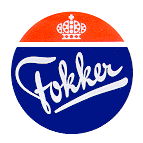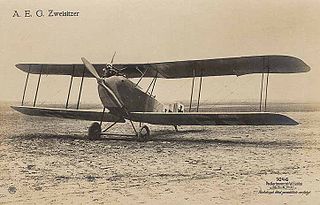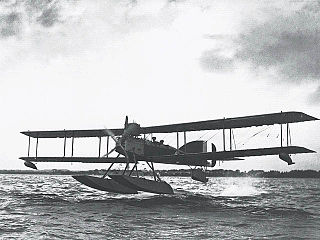
Fokker was a Dutch aircraft manufacturer that operated from 1912 to 1996. The company was founded by the Dutch aviator Anthony Fokker and became famous during World War I for its fighter aircraft. During its most successful period in the 1920s and 1930s, Fokker dominated the civil aviation market. The company's fortunes declined over the course of the late 20th century. It declared bankruptcy in 1996, and its operations were sold to competitors.

A heavy fighter is a historic category of fighter aircraft produced in the 1930s and 1940s, designed to carry heavier weapons or operate at longer ranges than light fighter aircraft. To achieve performance, most heavy fighters were twin-engine, and many had multi-place crews; this was in contrast to light fighters, which were typically single-engine and single-crew aircraft. In Germany, these larger fighters were known as Zerstörer ("destroyers").

The AEG C.IV was a two-seat biplane reconnaissance aircraft designed and produced by the German aircraft manufacturer Allgemeine Elektrizitäts-Gesellschaft.

The Albatros B.II, was an unarmed two-seat reconnaissance biplane designed and produced by the German aircraft manufacturer Albatros Flugzeugwerke. It was the aircraft that brought Albatros Flugzeugwerke to the world's attention.

The Morane-Saulnier L, or Morane-Saulnier Type L, or officially MoS-3, was a French parasol wing one or two-seat scout aeroplane of the First World War. The Type L became one of the first successful fighter aircraft when it was fitted with a single machine gun that fired through the arc of the propeller, which was protected by armoured deflector wedges. Its immediate effectiveness in this role launched an arms race in fighter development, and the Type L was swiftly rendered obsolete. The original Type L used wing warping for lateral control, but a later version designated Type LA was fitted with ailerons.

The Fokker G.I was a Dutch twin-engined heavy fighter aircraft comparable in size and role to the German Messerschmitt Bf 110. Although in production prior to World War II, its combat introduction came at a time the Netherlands were overrun by the Germans. The few G.Is that were mustered into service were able to score several victories. Some were captured intact after the Germans had occupied the Netherlands. The remainder of the production run was taken over by the Luftwaffe for use as trainers.

The Fokker D.XXI fighter was designed in 1935 by Dutch aircraft manufacturer Fokker in response to requirements laid out by the Royal Netherlands East Indies Army Air Force.

The Fokker C.V was a Dutch light reconnaissance and bomber biplane aircraft manufactured by Fokker. It was designed by Anthony Fokker and the series manufacture began in 1924 at Fokker in Amsterdam.

The Short Admiralty Type 184, often called the Short 225 after the power rating of the engine first fitted, was a British two-seat reconnaissance, bombing and torpedo carrying folding-wing seaplane designed by Horace Short of Short Brothers. It was first flown in 1915 and remained in service until after the armistice in 1918. A Short 184 was the first aircraft to sink a ship using a torpedo, and another was the only British aircraft to take part in the Battle of Jutland.

The Fokker T.V was a twin-engine bomber, described as an "aerial cruiser", built by Fokker for the Netherlands Air Force.

Friedrichshafen FF.49 was a German, two-seat, single-engine float-plane designed by Flugzeugbau Friedrichshafen in 1917.

The Albatros B.I, was a German military reconnaissance aircraft designed in 1913 and which saw service during World War I.

The Hansa-Brandenburg W.12 was a German biplane fighter floatplane of World War I. Ernst Heinkel's KDW was redesigned, with a rear cockpit, reshaped tailfin, and rudder.

The Fokker C.I was a German reconnaissance biplane under development at the end of World War I. The design was essentially an enlarged Fokker D.VII fighter with two seats and a 138 kW (185 hp) BMW IIIa engine. The C.I was originally developed to sell to the German Army. It never saw service in World War I, but Anthony Fokker managed to smuggle parts out of Germany at the time of the Armistice.

The Fokker A.I was an "A-class" unarmed two-seat monoplane observation aircraft of the 1914-15 era early in World War I, powered as the earlier Fokker M.5 was, by a 58.8 kW (80 PS) Oberursel U.0 seven cylinder rotary engine, or umlaufmotor, a near-clone of the Gnome Lambda rotary engine of the same power output level — the same U.0 seven cylinder rotary engine version was used on all Fokker military monoplanes before the Fokker E.II Eindecker fighter's debut in 1915-16. The A.I aircraft resembled a substantially enlarged Fokker M.5, with a tall dorsal cabane structure to handle the triple sets of stationary flying and landing wires anchored to the wing panels' forward spar, each panel having fourteen wing ribs, and the similarly triple sets of wing warping cables attached to the rear spar. The A.I and earlier A.IIs were both built by Fokker and license-built by Halberstadt. The origins of the A.I, A.II and A.III were in a Morane-Saulnier Type H purchased from France. This led to the initial Fokker M.5 airframe designed by Martin Kreutzer, from which the larger A.I was derived. Fokker gave many aerobatic demonstrations in the M.5 on the eve of World War I. The M.8, was ordered as the A.I by the Fliegertruppe and between Fokker and Halberstadt, about 63 were produced.

The Friedrichshafen FF.29 was a maritime reconnaissance floatplane built for the Imperial German Navy's Naval Air Service that was produced by Flugzeugbau Friedrichshafen during World War I. The aircraft entered service in November 1914, mostly conducting maritime patrols over the North Sea and the English Channel, and played a small role in the Raid on Cuxhaven the following month. A FF.29 became the first aircraft to be transported by a submarine when it was used in experiments in January 1915. In May an emergency landing by a FF.29 was the cause of the action off Noordhinder Bank when German forces were searching for the floatplane when they encountered a superior British force. The aircraft was also involved in developing methods of controlling artillery fire from the air.

The Fokker T.IV was a Dutch torpedo bomber/maritime reconnaissance floatplane of the 1920s and 1930s. First flying in 1927, it served with the Dutch Naval Aviation Service in the Dutch East Indies until the remaining aircraft were destroyed during the Japanese invasion in 1942.

The Fokker C.VIII was a reconnaissance aircraft built in the Netherlands in the late 1920s. Intended primarily for the photographic reconnaissance role, it was a larger machine than other Fokker reconnaissance types of the period, with space for a third crew member, who acted as camera operator. It was also Fokker's first aircraft of this type to be built as a monoplane, a parasol wing configuration. The construction, however, was in the familiar Fokker style with wooden wings covered with plywood and fabric, and a steel-tube fuselage, also fabric-covered.

The Friedrichshafen FF.19 was an unarmed maritime reconnaissance floatplane built for the Imperial German Navy's Naval Air Service that was produced by Flugzeugbau Friedrichshafen. Built in small numbers, the aircraft first flew in 1914 and saw service during the early months of World War I, mostly conducting maritime patrols over the North Sea, although they did attack British ships participating in the Raid on Cuxhaven at the end of the year.






















